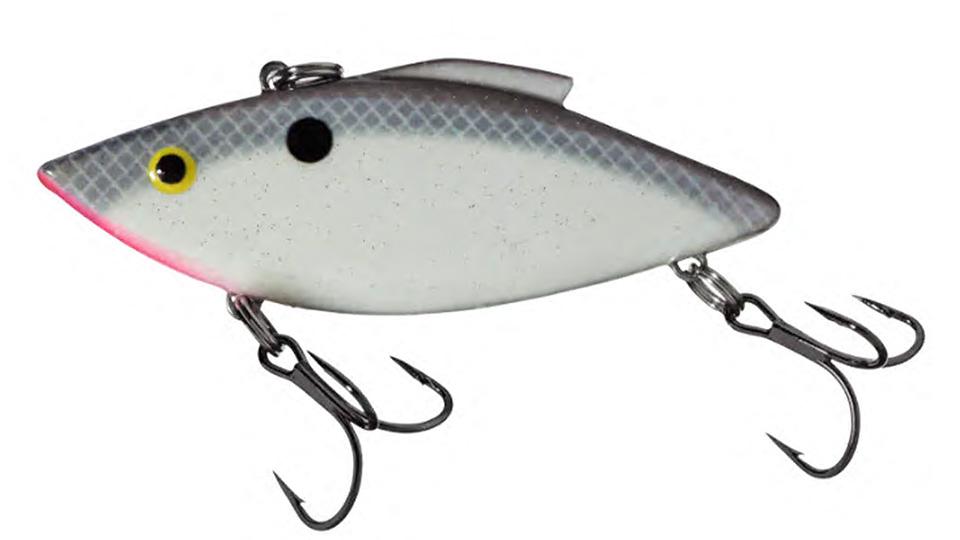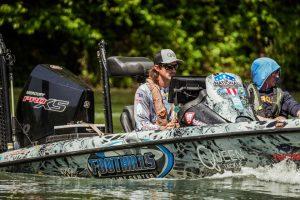Story by Ken Duke
First, let’s establish the boundaries. Lipless crankbaits are different from “crankbaits” because they do not have a diving lip. Instead, they often feature a flat or slightly rounded planing surface on top of the bait that gives these lures their characteristic fast vibrating action when retrieved.
Most lipless crankbaits sink, but a few are made to float. Most have BBs or rattles or something inside their hollow plastic bodies that cause them to make noise when retrieved, but some lack these noisemakers and are silent … at least to the human ear.
Lipless cranks have been around a long time. The first lipless crankbait made for the bass fishing market was the Heddon Sonic, which was introduced in 1957. Heddon billed it as “the lure that broke the sound barrier” (a hot topic during the ’50s), even though the Sonic did not have BBs or rattles. Instead, the company maintained that fish are attracted more by noise than by sight. Whether that’s true or not probably depends on a lot of specific environmental factors, but one thing was certain. The Sonic was a huge hit. In 1966, Heddon made over two million baits and a quarter of those were Sonics.
A few years after that a bait maker named Bill Lewis (1921-2005) introduced a lipless crankbait that rattled—the Rat-L-Trap. Whether it rattled by design or by providence we will leave to lure lore, but it certainly rattled, and it caught fish. Still does, in fact.
The Rat-L-Trap caught so many bass and so many first bass for so many beginners that it eventually put the Sonic out of business (1983) and set the standard for other lipless crankbaits so that the name “Rat-L-Trap became synonymous with the lure type, much like we say “Kleenex” when we mean “tissue” or “Coke” when any cola will do.
Today, the Rat-L-Trap—still in mass production and available in dozens and dozens of colors—is almost certainly the most ubiquitous lure in the bass world. It’s hard to imagine any angler who has been in the sport for more than a year or two who doesn’t have at least a couple of Rat-L-Traps.
It’s easy to understand why. Lipless crankbaits are incredibly versatile and remarkably easy to fish … at least to a degree. If you can cast and crank, you can fish a lipless crankbait. And if you can cast accurately and envision what your bait is doing while you successfully manage its speed and depth, you can be a master.
At least seven things make the lipless crankbait a staple in every bass angler’s tackle box.
First, they cast like a bullet. Even beginners can usually throw them long distances.
Second, they sink. The slower you retrieve them, the deeper they go; the faster you crank them—and the higher you hold your rod tip—the shallower they run. They cover the water column from inches deep all the way to the bottom.
Third, you can manipulate their depth not only by your retrieve speed, but by the weight of the lure (heavier = deeper), the size of your line (heavier = shallower) or the gear ratio of your reel (higher gear ratios allow for faster retrieves).
Fourth, the ones with rattles make a lot of noise, which may or may not attract bass depending on a variety of conditions we won’t dive into here except to say that even the ones without rattles make a lot of noise underwater in the form of vibrations.
Fifth, since most lipless crankbaits come with a couple of treble hooks, anything that tries to eat one is usually going to get stuck … at least a little.
Sixth, because they come in every color under the sun, you can find lipless cranks to emulate baitfish or crayfish or anything else a bass might want to eat.
Seventh, few lure types are better at “covering water.” If the fishing’s slow, plenty of top pros will tie on a lipless crankbait and go “chunkin’ and windin’.” They figure they’ll eventually cross paths with a hungry or aggressive bass that will take a swipe at the lure.
With all those positives, there must be a few negatives … and there are.
Because lipless cranks usually feature a couple of treble hooks but no lip to help fend off snags, they get hung up—especially in vegetation. This doesn’t exactly make them “open water” baits, but you need good casting skills to throw them in and around cover.
And because these baits are usually fished fast and anglers sometimes fail to set the hook with authority, losing fish can be a nagging problem with lipless baits. To combat that, consider a medium to medium-heavy action rod—at least 7 feet long—with a parabolic action to keep pressure on the fish. A high-speed reel will help, too—at least 7:1 with casting models—especially if the fish is moving toward you when it hits. Keep your rod tip low, and don’t rush things. The most common time to lose a fish when using these baits is when they jump and shake their heads.
Ultimately, the old axiom anglers use too often when talking about certain lure types may actually be true about the lipless crankbait: “The only wrong way to fish it is not to fish it at all.”





